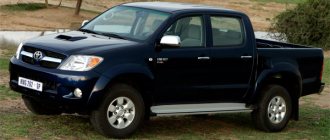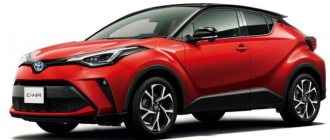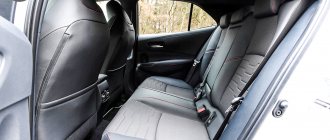Since 19237, the world's largest Japanese automobile corporation, Toyota, began its path to success. If during the war and post-war times its main goal was to provide the Japanese Imperial Army with trucks, then already in the 50s passenger cars began to roll off the assembly line. In 1957, Toyota Crown expanded beyond Japan, making the company popular and in demand in the United States and Brazil. In 2014, the company's cars became the most popular in the world. According to the study, approximately 10,594,000 units were sold worldwide in 2021. For the last 5 years, the mark has not fallen below 10 million cars per year. One of the best-selling models was the Toyota Camry , first released in 1982.
general description
Toyota Camry is a middle or business class car (depending on the year of manufacture), which is in great demand among car enthusiasts in the USA, Japan, Russia, China and Australia. Surprisingly, European drivers, despite all the advantages of the Camry, preferred another model - Toyota Avensis . For this reason, since 2004, exports to Europe for cars not in demand by the buyer have been closed. In Russia, motorists are actively purchasing Camry, based on its relatively affordable price and reliability in operation. Based on this, in 2005 it was decided to create a branch for the production of Toyota products in Russia in the small village of Shushary, Leningrad Region. Just 2 years later the first car rolled off the assembly line. This event had a positive impact on sales among Russians.
First of all, the buyer is attracted by the stylish appearance combined with reliable protection . A Japanese car by replacing natural wood in the interior with plastic, but this did not at all affect the safety of movement in the car. In general, this is the main feature of the Toyota Camry, thanks to which it is extremely popular among car enthusiasts around the world.
One cannot help but be surprised by the intelligence of the car, which has the function of recognizing the level of driver fatigue, warning of the presence of pedestrians ahead and warning of a frontal collision. The latter function is accompanied by braking to avoid an emergency. But despite all the advantages of the car, there are annoying shortcomings that are also worth mentioning.
Review of Toyota Camry 2.5 (200 hp) 8 automatic transmission (2021)
Greetings, colleagues!
Kamryuha has currently run 2.5 thousand km, there have been a couple of relatively long trips (300 km), it’s time to share first impressions, as well as make a comparison with the Volvo S80 - they are still direct classmates, if you don’t take into account the “premium raid” on the Volvo.
To begin with, I would like to go over the configurations/functionality - what did I get in return? And everything is practically the same, with minor advantages in favor of one vehicle or another. So I lost the adaptive headlights, but instead got diode light, which is superior to the Volvo xenon in terms of brightness/range. But here it is worth making allowances for age - over time, of course, the reflectors in the Volvo became faded, a coating appeared on the inside of the glass, and the lamps became tired. If my car had been delayed, I would definitely have replaced the modules, lamps and refreshed the windows. But okay, this is already lyrics. Let's compare the facts - what we have.
The biggest loss is the automatic braking system (CitySafety), which the Camry does not have in my configuration. And even though this thing on the Volvo has never worked for me in all my time, it would somehow be more comfortable with it, just let it be. Camry can only counter this with two(!) front parking sensors located at the corners of the bumper, which do not see obstacles when parking perpendicularly, but only make maneuvering in tight spaces a little easier.
Also, the Camry does not have a backlight when entering the cabin - the Volva had light bulbs in the mirrors, and a button on the remote control with which you could turn on the whole thing along with the side lights. Here Camry can only respond with LED DRLs.
The Camry also doesn’t have an air quality control system - it turns out that in the Volvo this thing worked very well, which I only realized when I got stuck in a traffic jam behind a Kamaz while in a Toyota).
Continuing the theme of losses - the electrified driver's seat does not have settings memory, but Toyota's lumbar support adjustment is also electrified (Volvo had a not very convenient thumb for this). But because I drive alone - in general, I don’t care about this memory. The front passenger was much more screwed up - the Camry offers seat adjustment in only two directions - forward-backward and backrest tilt, while the Volva had a full range of adjustments, including the height/tilt of the pillow, lumbar support.
Now about where it arrived. Here, first of all, I would like to note the heated windshield (over the entire area), heated steering wheel, keyless entry and a rear view camera. Less significant features include support for AndroidAuto/CarPlay, three USB sockets for charging smartphones and auto-hold.
In general, as you can see, there is no global difference in equipment.
Let's move on to comparing salons. In terms of seat comfort there is +/- parity - the S80 had a slightly longer cushion, the Camry has a more pronounced profile. The only criticism is that for tall passengers in the Camry, the corners of the backrest put a little pressure on the shoulders, which becomes noticeable after a few hours behind the wheel. In general, both the seats are quite comfortable, including on long trips, but they are both far from the reference (for me) seats that were in the S60. I won’t compare the quality of the “skin”, everything is obvious here.
But what I would like to compare is the performance of multimedia. And here only the lazy did not criticize Toyota for the inferiority of the GI, and it was so, it is so, and probably it will always be so. And it would be okay if she was lagging behind in comparison with her modern classmates, but she completely outperforms even the Volva, which appeared 10 years earlier! Both in terms of usability and graphics and display resolution. It’s like a no-name smartphone from AliExpress for $20 compared to some iPhone 5 (or whatever it was in 2012). A shame! For comparison, I’ll just insert two pictures, for example, with trip statistics, and I won’t even comment on it.
After all, a car is not a smartphone, to hell with the pictures, I don’t really look at them. But these bastards, as if on purpose, during the restyling proudly installed this Shit Device above the dashboard, in a modern way, so that it was difficult to leave it without attention. Moreover, ergonomists were clearly not invited to this restyling, because now the hand of a healthy person cannot reach the right row of buttons without lifting the back from the seat. And this thing cannot be completely turned off - the screen will always be on.
Okay, otherwise everything is quite convenient, understandable, and readable.
The sound quality of music is much more important to me than pictures, and it’s quite difficult to compare here. Because in Toyota, a lot depends on the sound source and the frequency range of the tracks being played. For example, the radio sounds insipid, from a flash drive or via Bluetooth, in some compositions the acoustics produce a good “tut-tut.” However, the highs are still oversaturated, the lows are cut somewhere around 80 Hz. In the Volva, the sound was more natural and balanced, but with less bass potential, a four in general. The Camry has a B minus. And yes, we are talking about the JBL audio system, the basic one is probably quite sad. Again, I would like to remember with kind words the S60 - that’s where the truly high-quality sound was!
In fact, the rear seat of the Camry turned out to be more spacious than the S80, but only by a few millimeters. The trunk is more spacious in terms of displacement (30-40 liters), the opening is wider, but the shape of the trunk in the S80 was more regular (rectangular), a larger opening opened into the cabin when the back of the rear sofa was folded, plus there was a hatch for long items, and there was also a cool feature — folding the back of the front passenger seat forward, so that you could carry some Ikea over 2 meters long. And the electric scooter fit into the trunk of the S80 across, into the very corner under the back of the sofa, without getting in the way at all. In the Camra it rests against the sides somewhere in the middle of the trunk.
Where else Volva gives Toyota its thoughtfulness is in the shape of the body in the context of geometric cross-country ability. Not only was the S80 taller by a centimeter or two (especially in the sills), but its front bumper was just the perfect shape - it had a decent bevel along the bottom in the horizontal plane, plus the corners were “cut off”, so it looked like a sharpened pencil . For Camry, it is almost a rectangular parallelipiped. Moreover, on uneven surfaces the amplitude of body vibrations is much greater than that of a Volva, so getting this bumper into a hole won’t be too difficult. I really want to add a couple of cm of ground clearance in front. He also noted that the Toyota has a larger turning radius - some maneuvers were easier on the Volvo.
Comparison of geometry in the photo:
As a result of reading all of the above, the reader may get the impression that I am disappointed with my choice... Whatever the case! The rubber-polyethylene leather and the radio from Alibaba did not come as a surprise to me - this is true to tradition. Although Toyota is slowly moving away from these traditions - they have removed the clock from the dashboard a la Elektronika-7, and the poker under the hood has given way to gas struts! There is also progress on the technical side - under the hood there is now a 200-horsepower engine with combined injection, equipped with an 8-speed automatic transmission, which together promises outstanding fuel efficiency and stunning dynamics, measured in 8.7 seconds to one hundred.
In practice, of course, at first it was sad after the turbo, because... These Toyota horses with Newtons are grazing somewhere near the red zone of the tachometer. Despite the passport difference in acceleration to one hundred in just over a second, in practice it turned out to be a whole abyss. Because on the Volva, 90% of the acceleration occurred in the range of 1500-2500 rpm, and in most cases this was faster than the main flow in the city, but on the Camry, acceleration comparable in intensity is obtained only after 3500 rpm. Fortunately, the 8-speed Aisin works clearly, quickly, and at the same time smoothly - unlike the wretched 6-speed on the Volvo. However, I would cut the hell out of 8th gear, at least with this engine. Because after 100 km/h at speeds of less than one and a half thousand, the car can drive in 8th gear only in the absence of climbs and accelerations and with a tailwind. You need to accelerate a little - it drops into 7th, a small hill - it doesn’t take you out of 8th either... Some discomfort appears in traction control, that is, for example, if the position of the gas pedal remains unchanged when driving uphill, the speed begins to drop, to maintain speed you press on gas - the transmission drops a gear (or even two), and the speed is already picking up, you have to release the pedal. In general, you seize this moment so that the car drives evenly.
Although in general there is enough dynamics, including for overtaking. You just need to not be shy about pressing the pedal and not shy away from the roar of the engine. Yes, the turbocharged engine drove easier and more cheerfully, but it consumed one and a half times more gasoline than the current atmosphere, both in the city and on the highway. In numbers, this is 8-9l/100km versus 5.5-6l/100km on the highway in 110-130km/h mode, 13l/100km versus 9l/100km in dense city traffic.
In terms of noise insulation, the difference is insignificant, the Volvo is just a little quieter. With the exception of the arches - here, again, the Japanese are true to tradition. Water, pebbles, sand - you will always know what is currently under the wheels.
I would like to add my two cents about “respect on the road,” no matter how much this phrase offends me. The topic for discussion is so-so, however, I noticed that changing lanes began to be much easier than on a Volvo - when the turn signal is turned on, no one in the next row pushes, deliberately shortening the distance, no weirdo with the letter “m” tries to cut, squeeze, or brazenly get in front nose, much more often a thank you arrives in the form of turning on the emergency lights in response to a pass, etc.
That’s why I really fell in love with the Camry and am ready to forgive it for all its multimedia with eco-leathers - it’s for the suspension, which is, without exaggeration, chic. While handling is at least no worse than that of the S80, the Camry with its velvety smooth ride turns out to be head and shoulders more comfortable than the Volva on any type of surface! Goodbye to the chiseling on every asphalt crack and a rough kick when passing speed bumps... And here, for a second, it is worth noting that the Volva was shod in Goodyear in size 225/50 R17, while the Camry from the factory had a wooden Bridgestone Turanza in size 235/45 R18. For me personally, the comfort/handling balance of the current generation Camry is simply excellent; it’s not without reason that some auto journalists compare its suspension to the Eshka W212. There is not even a hint left of the “cotton wool” of the previous generation - the response to the steering wheel occurs without delay, roll is very moderate. Now it’s not scary to “screw in”, and it’s relaxed to keep 180 along the highway (I haven’t accelerated again yet).
Camrys are like comfortable sneakers that don’t pinch, don’t rub, and you don’t notice them on your feet at all, even after walking for many hours.
A recent example from life - I took a ride with a colleague in his Kia K5. Of course, I was very sad when he showed me all the features of the graphical tidy, with changing themes and displaying an image from the camera in the rear-view mirror when the corresponding turn signal is turned on, a la monitoring of blind spots. All these buttons, lights, screens are simply top notch for the money, what can I say! But my sadness did not last long, exactly until the first speed bump - a hard kick accompanied by a ringing double “dydyshch”, and my priorities set themselves... “You don’t need such a car, Vovka.”
But who really made me bite my elbows was an acquaintance who bought an Octavia 1.4T at maximum speed for exactly 2 million. By the way, I also went to Skoda, being aimed at Toyota, and I drove this one a little on an Octavia as part of a test drive. I liked everything about it, except for the pricing of cars in stock or in nearby transit - OD did not hesitate to charge 300+ TR. to the price list, offering me an Octavia 1.4T in the middle configuration with a fabric interior with fur. adjustments and on 16" wheels for 2.3 million rubles, almost the price of a Camry... A friend ordered a car and waited for it for six months, in the end for 2 million he has a top speed with a combined interior, 17" wheels, adaptive cruise, lane keeping system and many other goodies. This is the option I would buy for that kind of money! And the dog with her with this beam.
In the flight of my thoughts, I came to the conclusion that the Octavia seemed to cover my need for a crossover, which I was considering primarily because of the convenience and trunk volume (here the Octavia will give a light to many crossovers), and secondly because of the ground clearance ( with him, as with geometry, Octavia is also in complete order). Well, the engine is captivating - 150 turbo horses with a wide torque range in everyday use is much more convenient than 200 naturally aspirated ones with an identical maximum torque available in a very limited range. They say it also consumes less than 5 liters on the highway. 
I was wondering if I should go and order such an Octavia with a minimum refundable prepayment, and when it arrives, see what the price will be and how much the Camrya will cost...
A few final photos
Advantages of Toyota Camry
At the moment there are 9 generations of this model. Each new development of the company is equipped with parts produced using the latest technologies, keeping up with the times. However, more outdated models are in no way inferior in quality to cars of recent years. Some owners, in principle, purchase cars of previous generations, considering them more reliable. In any case, a large number of car enthusiasts around the world never stop striving to buy a Camry. What advantages attract drivers so much?
- First of all, Toyota Camry is valued for its high reliability . Most owners claim that with careful care and careful driving, repairs are not carried out.
- Inexpensive maintenance is a point that follows from the first. High-quality consumables for a “Japanese” car are not cheap, but due to the quality and proper operation of the car’s parts, the car rarely needs to be repaired, which certainly helps save money.
- High comfort and luxurious equipment , which makes the car equal to the business class level.
- Relatively low cost for a quality car.
- The engines are adapted for Russian fuel.
- Classic appearance , despite more advanced design with each new generation.
- The spacious interior pleases both the driver and passengers.
- It is easy to start and warms up quickly even in the harsh Russian winter.
- The car does not rust for a long time , despite a large amount of precipitation and high humidity, which significantly increases its service life and its liquidity.
- Smooth automatic transmission operation.
- Low fuel consumption for a car of this power, especially when driving on the highway outside the city.
- Liquidity . The opportunity to sell a Camry for the same money after a few years attracts more car enthusiasts. This quality is inherent in the car thanks to the high-quality original parts used during assembly.
- Trunk capacity . Although some owners of the new generation Camry note reduced trunk space, it can still be used rationally and guarantee high capacity.
Toyota Camry V40 3.5 V6. Pros and cons of this car
Let's talk about the Japanese eternal car in a simple, everyday format: through the eyes of the owner. The 40th body is quite heavy, under 2 tons, strong, looks quite attractive, round in shape. Driving the Camry is conducive to a quiet ride, although 277 hp. can do incredible things. Based on this, let's briefly move on to the pros and cons so as not to throw too much water.
Pros:
- E-class car: soft, heavy, comfortable;
- the build quality is impeccable, nothing creaks inside;
- low consumption for the 3.5 engine: on the highway at a speed of 120 km/h - 7.8-8.1/100, at a speed of 140-150 km/h - 9.2-9.8/100, urban cycle about 11-14/100. For a 3.5 V6 engine this is truly incredible.
- reliability of the technical part: with timely maintenance up to 150,000 km (although for a Camry 200,000 km is not a mileage at all), you can completely forget any breakdowns.
Minuses:
- 277 hp for front-wheel drive, of course, it’s a bit much - when you press “to the floor” from the start, the wheels begin to hit the steering wheel;
- again, when you press the floor at a speed of, say, 80 km/h, you need to catch the car: 277 hp. and the front-wheel drive makes itself felt, you need to hold the steering wheel very tightly, the car throws from side to side;
- Headlight washers: many people turn them off because they automatically work when the windshield is washed. This is one side. It’s another matter in winter - they just freeze and don’t go back in, so they stick out until the water freezes.
- The most unpleasant thing is the disease of this generation Camry: an incomprehensible knocking sound when you start the car when it is cold. I’ll explain what it is and why it’s not critical: many mechanics refer to valve knocking, others shout that these are chain tensioners from which oil is draining and that’s why knocking occurs because the oil hasn’t had time to reach. In fact, everything is different: oil drains on all cars, but the sound is only on 3.5 liter engines. This crackling noise can be either in the right or left cylinder head, or in both at once. The problem is with the VVT-I gears - there is one on each camshaft - there are only 4. The reason is that oil drains from them, although it should not. To hold the internal piston until oil gets in, the manufacturer made a spring clamp, the life of which is not long. Therefore, just accept it, there is nothing critical in this, and you can’t even hear anything hot about it.
And if we make a generalization, then I am completely satisfied with the car. They respect expensively, where you need to click, takes care of your 5th point for your money very well. Soft leather, plenty of space in the back, average sound insulation, good music. In general, they made a good car for their money, it’s a pity that the Russian assembly may be more beautiful, but the quality is much worse, much worse.
Cons of Toyota Camry
Although there are very few shortcomings, they still exist:
- Paint coating that is not resistant to the harmful effects of the external environment.
- High cost of CASCO insurance.
- The 2.4 liter engine can occasionally be subject to thermal shock.
- The pre-styling V6 model suffers from accelerated oil consumption due to failure of the connecting oil pipe.
- There are problems with the steering shaft. If there is noise, the breakdown must be repaired immediately.
- Cheap materials for interior design (wood and steel replaced with plastic).











